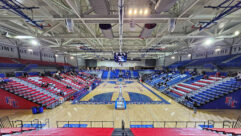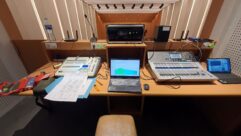Waterful soundThe musical fountain in Grand Haven, MI, combines water, light and music for a spectacular show.
Nov 20, 1996 12:00 PM,
Marie BryanBryan is a free-lance writer who writes for the sound and video industry.
The world’s largest musical fountain presents an integration of sight, sound and nature at an unprecedented level of beauty and enjoyment.
Since 1963, millions of people visiting Grand Haven, MI, have been treated to the fountain’s performances. One of the most fascinating man-made wonders of the world, the fountain represents the vision of civic-minded residents determined to create and maintain something genuinely unique in the place they live.
The fountain sits about one-third the distance up a sand dune known as Dewey Hill and directly across the Grand River Channel from the heart of downtown Grand Haven. Nightly performances during the summer months vary in style, but they all feature the fountain and lighting synchronized with a dynamic soundtrack.
The fountain’s basin is almost as long as a football field, with more than one mile (1.61 km) of piping pumping up to 40,000 gallons (152,000 liters) of water, which often sprays to heights reaching 125 feet (38 m). Dynamic lighting – 125,000 W worth – illuminates the fountain throughout its nightly 20-minute performances held during the summer.
The viewing area spans beyond both ends of downtown. The Waterfront Stadium, which is approximately 1,000 feet (305 m) across the river, serves as the primary observation spot. Boats also regularly drop anchor right on the river for the spectacle, and they form a virtual river-wide barge during the highlight of the summer programming season, the Coast Guard Festival.
The sound of musicThrough the years, a number of audio systems had accompanied the fountain. As one might imagine, the performance of these systems has steadily improved with the evolution of technology. A brochure developed to highlight the fountain during its early 1960s commencement touts “more than 400 W of audio power” with sound “distributed through a series of outdoor speakers.” Several incarnations and updates followed.
Audio Designs, a design and installation firm based in Grand Haven, began working with the city in mid-1995 regarding plans for a new fountain audio system. It had become apparent that the system put into place a decade before was becoming woefully inadequate in terms of performance and reliability.
The relationship between the company and civic leaders strengthened as the process continued. Audio Designs spent hundreds of hours in the planning stages, working to meet all of the criteria as well as wishes and dreams expressed by the city. During this process, the company came to believe so strongly in the project that it raised $25,000 to help defray costs and make the new system an achievable reality. The fountain was built and is maintained solely through private donations and is still managed by its original founder, Dr. Bill Creason.
Audio Designs got the official OK in mid-November to install the new system, leaving little time to meet a December 1 deadline for kickoff of the annual Nativity program at the fountain. Four crew members working full time got the system up and running in time. Walker credits the support of JBL and Casey McWilliams and Renee of CM Sales for helping things progress smoothly within the tight time frame.
New developmentsThe project presented a number of challenges outside the realm of what could be called a typical design. Topping the list is a rather difficult environment and landscape. The river channel is subject to strong and variable winds slicing off adjacent Lake Michigan. The coverage area is more than a quarter of a mile (0.4 km), and some of the coverage area is several thousand feet from the system. Terrain varies from water to downtown buildings to trees and hills. In addition, the city staff had requested that sound spillover be controlled. Charles Nelson, a Grand Haven city council member, cited reports that a previous lack of control had resulted in complaints from residents up to five miles (8 km) away.
The evolution and drastic improvement in audio technology helped Audio Designs meet these goals. Company president Steve Walker notes a lot has changed in the world of sound equipment over the past 10 years. He cites developments like neodymium compression drivers with titanium diaphragms, 3,000 W power amplifiers and vented gap 18 inch (457 mm) loudspeakers like those from JBL as examples applying to this project.The new system design called for a configuration somewhat similar to the previous one. Four low-profile cinder-block buildings would continue to serve as the home for the new JBL loudspeakers, with the loudspeakers that fire at the primary viewing area stored in the center buildings. New system processing and JBL power amplifiers providing in excess of 35,000 W would reside in a room beneath the fountain basin.
“At first glance, the new system looks quite similar to the previous one, especially in its configuration,” says Walker. “But if you look closely, we’ve doubled the number of horns in the center. And with the higher output of these devices, we’re able to achieve about eight times the acoustic power.”A distributed loudspeaker system situated close to the viewing area on signal delay with the main system might have been a suggested approach, but Walker said this wasn’t possible in light of potential theft or vandalism problems. Putting up inexpensive loudspeakers to alleviate the threat would lessen the high fidelity of the main system.
Coupling is key”As we progressed with the design, we realized that by coupling long, deep 40—20 horns together, and thus only having 20° of vertical coverage, we would convert a shotgun into a high-powered rifle,” Walker said. “With this approach, we were able to focus sound on the stadium and viewing area without shooting it off into the air.”Specifically, coupling each group of horns results in tighter control over higher frequencies and provides the added punch necessary to reach the farthest viewing points. The tight vertical pattern also controls sound that would otherwise be bouncing down the river and off buildings.
Each of the four buildings houses a quad block of loudspeakers – four horns in a two-over-two configuration, with two double 18 inch loaded subwoofer loudspeakers on each side of the coupled horns. The bottom edges of the lower horns rest only about four feet (1.2 m) above the level of the river, so these are aimed slightly upward.
Meanwhile, the upper horns are coupled inward toward each other at about 10°. During the installation process, they were focused to the same point and then widened out to increase the area of the sweet spot. The side horns are JBL 2365A large-format constant directivity horns; the eight in the adjacent center buildings are also large-format JBL 2366 horns incorporating constant directivity. All horns are loaded with JBL 2450 compression drivers.
“The 2450s provide the system with a nice, smooth sound that’s not honky,” Walker said. “They’re easy to tune to a pleasant cue.”Appropriate dynamic punch is provided by 16 JBL SR4719 subwoofers when needed. JBL told Audio Designs these subwoofers tended to perform best when provided with a lot of power, which Walker confirmed. “We hit them with 1,600 W apiece, and they’re very tight, holding together like nothing we’ve ever seen before from an 18 inch loaded loudspeaker.”The loudspeakers are usually protected by the buildings, and when not in use, they’re completely sealed off from the elements with closed garage doors. In addition, each loudspeaker was treated with extra weatherproofing to prevent any moisture damage.
Plenty of powerCable runs from the remote control room that houses power and processing proved a bit challenging. Using the original conduit runs, which were not designed for the amount of cable (24 pairs, AWG #8) the new system required, made a tight fit. Fortunately, an access point at the two-thirds point of the run aided the pulling process.Each subwoofer has its own dedicated power amplifier channel, with a total of eight JBL MPX 1200 amplifiers. Six JBL MPX 300 amplifiers run the compression drivers, and each amp receives a boosted signal feed via an AB International DA2148 distribution amplifier.
An Ashly XR-2001 crossover supplies four crossover channels, one for each quad block. Four Ashly GQX-3101 graphic equalizers provide custom, precise tailoring of each loudspeaker block. As a result, drivers have their own EQ curve, response, crossover point and output setting.
Soundtracks are played on a Panasonic 3700 DAT player feeding a Mackie 1202VLZ compact mixer. The tape player feeds, via a 300-baud modem, an Allen Bradley PLC-2/30 programmable master control system dating back to the fountain’s origins. The unit reads a magnetic coded tape programmed in sync with the musical selections and automatically sets relays that control the pneumatic water valves and lighting switches. Up to five functions can be read within one-sixth of a second, ensuring a dynamic program that’s perfectly calibrated. More than one trillion program variations are possible via the Allen Bradley.
Full and pleasantAudio Designs set up a mobile lab for testing and tuning of the new system using real time analyzers (RTAs), time energy frequency (TEF) analyzers and other tools. The city loaned the company a couple of its business radios for communication between the listening area and the system.
Walker noted that close-up levels generated by the system “would melt your skull,” but as one moves out to the river and beyond, sound is full and satisfying, with a crispy high end. Sound-pressure levels throughout the primary listening area maintain a solid 90 dB. The tuning philosophy was to remain unconcerned with signal above 8 kHz and correct any pulses, cracks and reflections caused by the river and buildings through signal processing and careful aiming and focusing of the loudspeaker blocks.
“With a system expected to deliver quality sound for an application like this, you need to come up with a great algorithm defining how you’re going to degrade the signal as it comes across the river,” Walker said. “You’re accommodating a huge area with diverse features, so you’re shooting for a happy medium. Given these conditions, you simply can’t try to be too hi-fi. Generating the high level of energy necessary can toast any compression driver if it’s pushed too hard. The primary goal is drama, which really comes from the low end. Other than that, we wanted the sound to be pleasant.”Testing the system in winter conditions proved to be a blessing in disguise. Boat traffic is nonexistent, and the dryer, thinner winter air proved much more forgiving than would the warmer, thicker air of summer. If the system tested well in the tougher climate, it would certainly perform well no matter the conditions.
The final test to evaluate sound spillover proved successful as well. “After three blocks, we lost signal completely,” Walker said. “To achieve this, especially in the dead of winter, meant that it was a job well done.”










